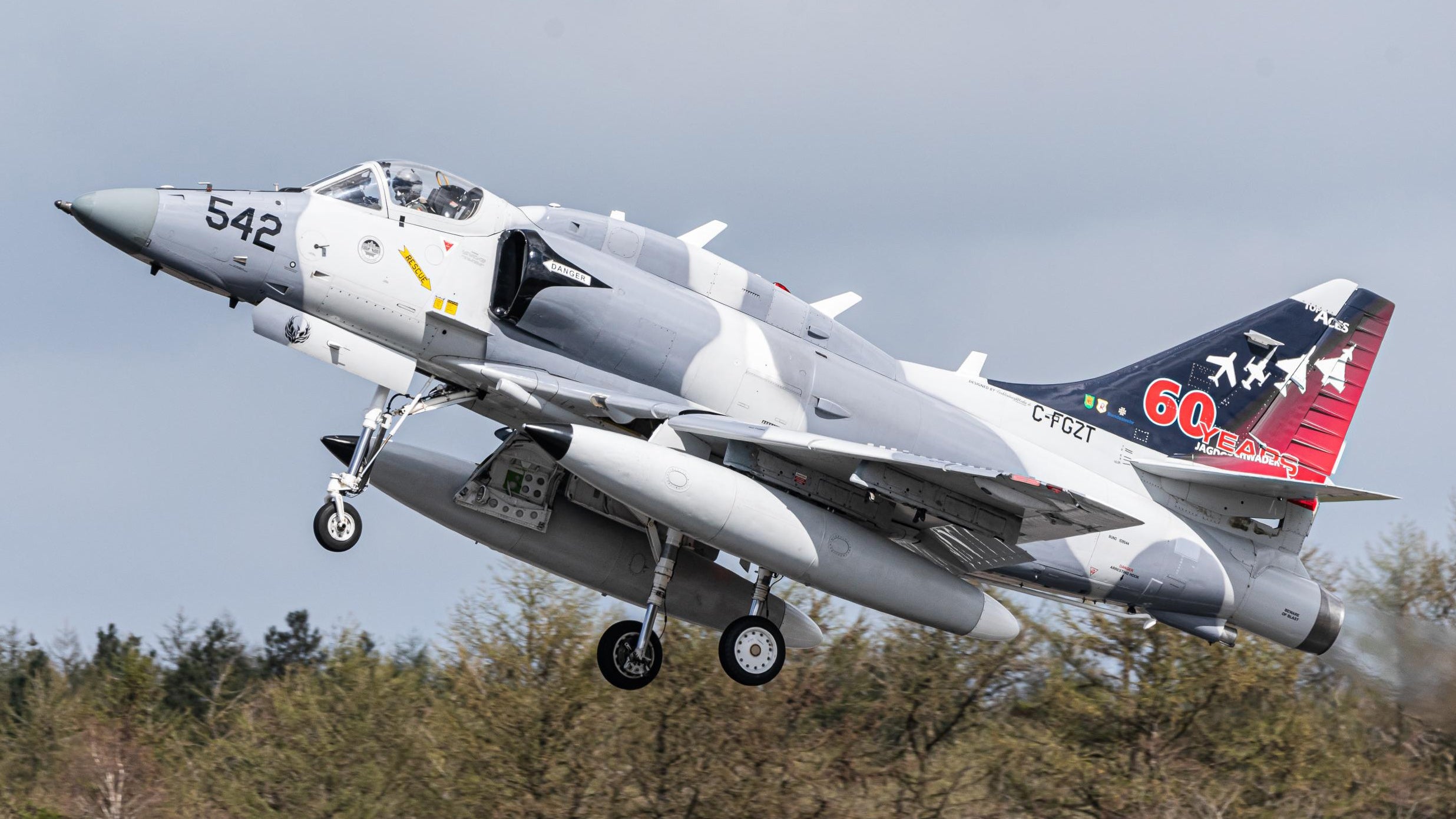Canada’s Top Aces advanced training provider, part of a growing field of private contractors offering “red air” adversary support, is equipping its fleet of A-4N Skyhawk jets with active electronically scanned array (AESA) radars and infrared search and track (IRST) systems. Photos at the top of this story and below show what is understood to be the first of these jets to be so modified and offer the best look at the planned configuration for these upgraded Skyhawks. Based in northern Germany, these aircraft are scheduled to begin training missions in their new configuration by next January.
Details of the advanced aggressor A-4N were provided when the company announced that Berlin had renewed its contract for high-speed adversary air training services. Top Aces has provided these for the German Armed Forces for the last six years, using non-upgraded Skyhawks. Prior to 2015, the same jets were operated in this role by BAE Systems. Top Aces says it will also now invest over $81 million to meet the revised training demands.
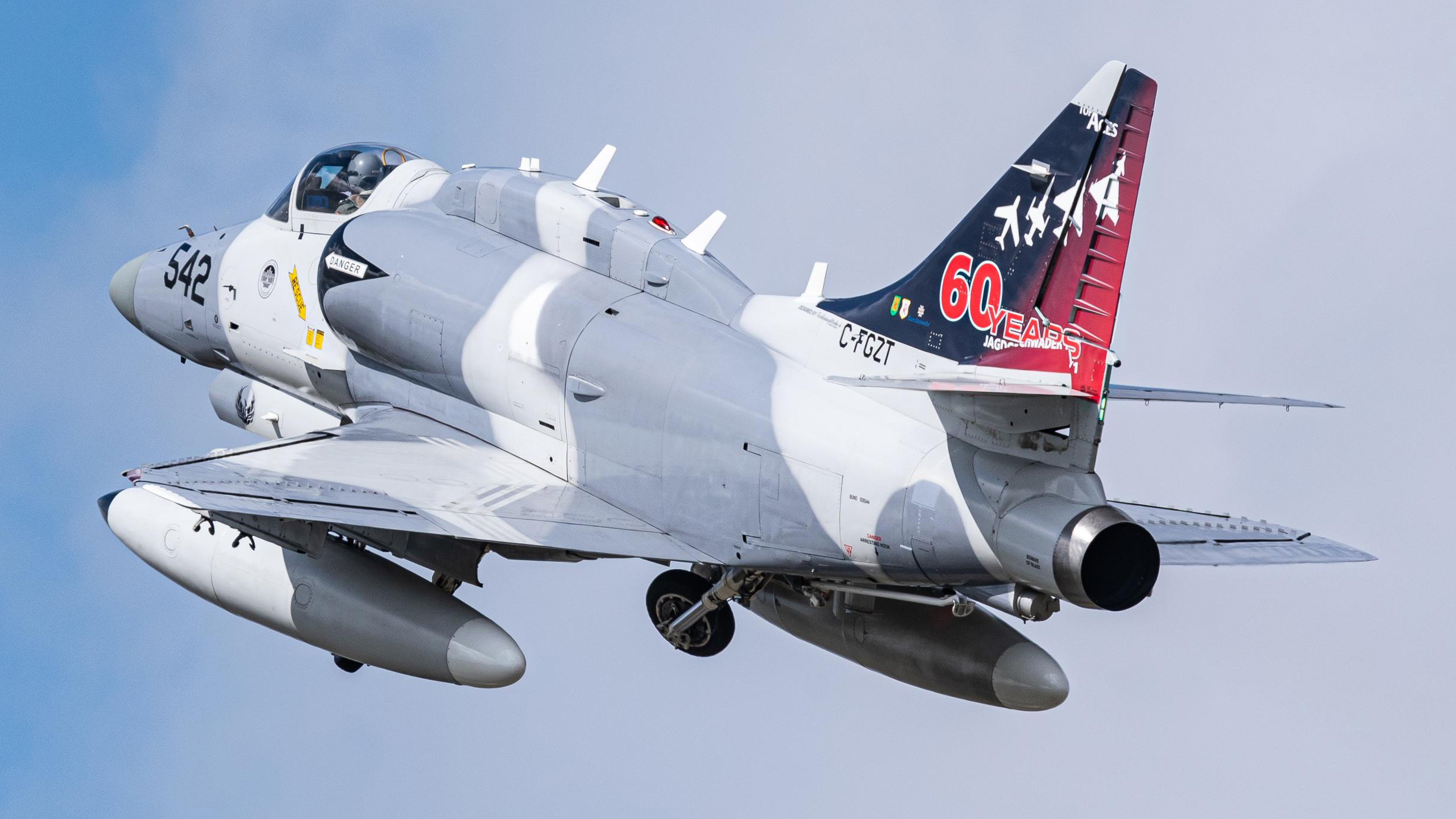
“As Germany’s trusted partner, we’re delighted to continue training its combat forces well into the future,” said Rolf Brandt, Senior Program Manager — German Operations at Top Aces. Brandt added that the contract renewal will add 20 news jobs at its German location.
While the German contract covers training for air, land, and sea forces, as well as target towing, the addition of AESA and IRST to the jets reflects the requirement of the Luftwaffe, or German Air Force, to train against aggressor jets that better replicate the latest kinds of threat aircraft, many of which also have these capabilities.
As The War Zone has reported in the past, AESA radars offer a significant boost in capabilities over similarly sized mechanically scanned arrays, including extended detection and tracking ranges, improved target discrimination and identification, and the ability to pick up low-flying targets with reduced radar signatures, such as cruise missiles. Without the need to physically move around a mechanically steered radar dish, AESA radars can rapidly scan huge volumes of airspace.
At least one Top Aces A-4N has already been upgraded with the AESA radar and is now at the company’s German operating location at Wittmundhafen Air Base, which is within reach of extensive training areas over the North Sea, where the jets regularly spar with Luftwaffe fighters and other allied jets. The company declined to reveal the type of radar that’s been fitted in the jet, but there has been speculation that it’s either an Israeli EL/M-2052 or the Italian Leonardo Vixen 500E. As well as a different nose cone, the upgraded jet also features an additional GPS antenna on the dorsal ‘hump.’
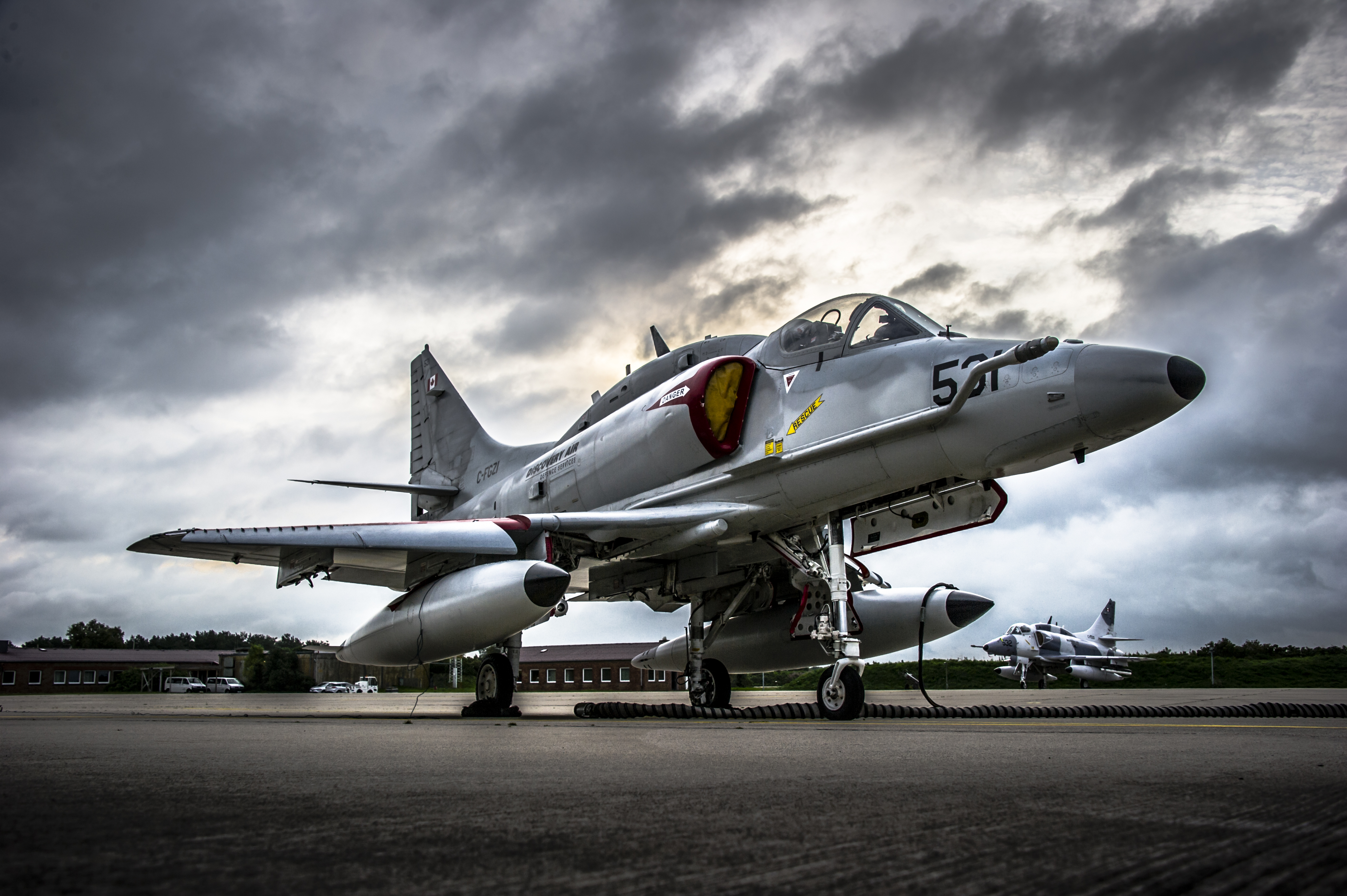
It is worth noting that BAe Hawk jet trainers operated by another red air contractor, Air USA, whose fleet we have discussed in the past, have also been upgraded with the EL/M-2052 AESA radar.
Top Aces also already has a significant Israeli connection, having acquired its A-4Ns from Israeli Air Force stocks, followed more recently by ex-Israeli F-16A/B fighter jets, the first of their kind to be delivered to a private red air contractor. You can read more about the Top Aces F-16s, which are intended to help meet the huge U.S. Air Force appetite for contractor adversary services in this previous feature of ours. The Canadian firm is also understood to receive sustainment support for its Skyhawk fleet from an Israel-based company.
However, the AESA radar is just one part of the upgraded Skyhawk package that will be used for training the German military, and potentially others, too. As well as being a requirement of the U.S. Air Force adversary air support contract, the U.S. Navy is also increasingly looking for AESA technology for the adversary aircraft it will train against in the future.
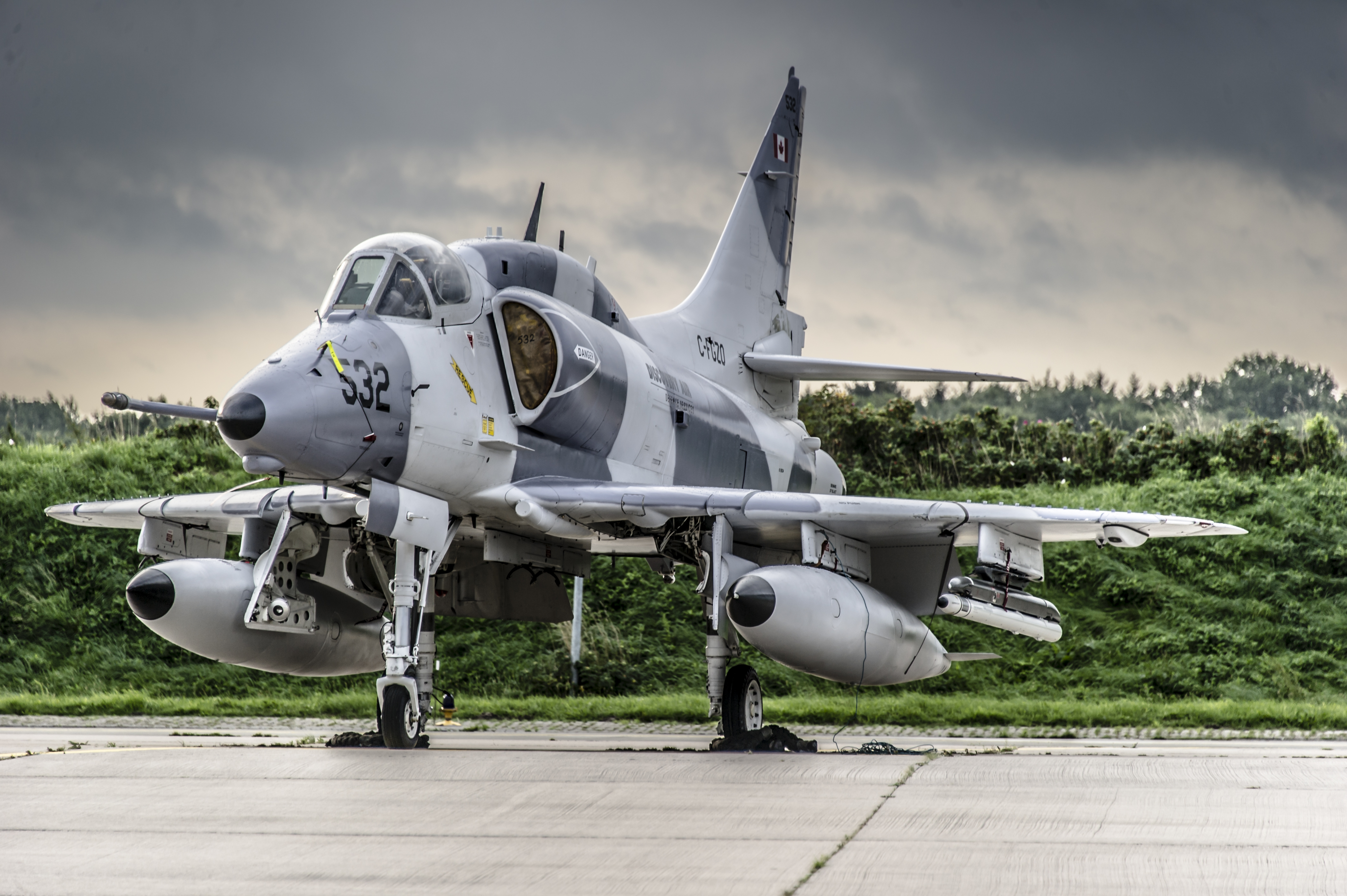
Since 2017, Top Aces has been developing its own Advanced Aggressor Mission System (AAMS), which is intended to be compatible with both its A-4s and F-16s. AAMS brings together the capabilities of the AESA radar and IRST system, with the result that the suitably equipped jets can “simulate the most advanced capabilities of modern-day opponents in air-to-air combat,” according to a news release from the company. It’s not been revealed how the IRST will be installed, but some kind of pod-based solution seems most likely. Should individual customers require other, or different sensors for aggressor training, AAMS is designed to support these as well.
The AAMS has completed flight testing on the A-4N and has now been certified, meaning it can now be used for adversary training in Germany. While the local armed forces remain the highest-profile customer, Top Aces’ Chief Operating Officer, Didier Toussaint, told The War Zone that the company is offering its services to other clients both in Europe and North America, too. “We continue to look at the expansion of the rapidly-growing European market and will deploy the best fleet and capabilities in response to individual client requirements,” Toussaint said.
As far as we know, the Top Aces A-4Ns are the first Skyhawks anywhere in the world to receive AESA radar and/or IRST sensors. In terms of situational awareness, they should provide a good match for many current frontline fighters. They will also be superior in at least some respects to the last Skyhawks still in actual military service, Argentina’s A-4AR Fightinghawk, and Brazil’s A-4KU.

The A-4AR has a variant of the Westinghouse AN/APG-66 radar, also used in early F-16s, while a handful of upgraded A-4KU jets are equipped with the Elta EL/M-2032. Both these are multi-mode pulse-doppler radars, but their mechanically-scanned technology is at least generation behind that found in AESA types. Other Skyhawks, minus AESA and IRST, are also operated by Draken International, another red air contractor, which flies them with AN/APG-66 radar. Another one of these companies, ATAC, has used A-4s in the past that were leased from Sky Resources.
Top Aces did not disclose how many of its A-4Ns will be upgraded with AAMS, and that the number will be determined “in response to client requirements.” Currently, Top Aces has seven A-4Ns in Germany. Should it need more, Skyhawks are still available from Israeli stocks, with more than 60 examples being offered for sale as of last year, some of which were still in Israeli Air Force service as advanced trainers as recently as 2015.
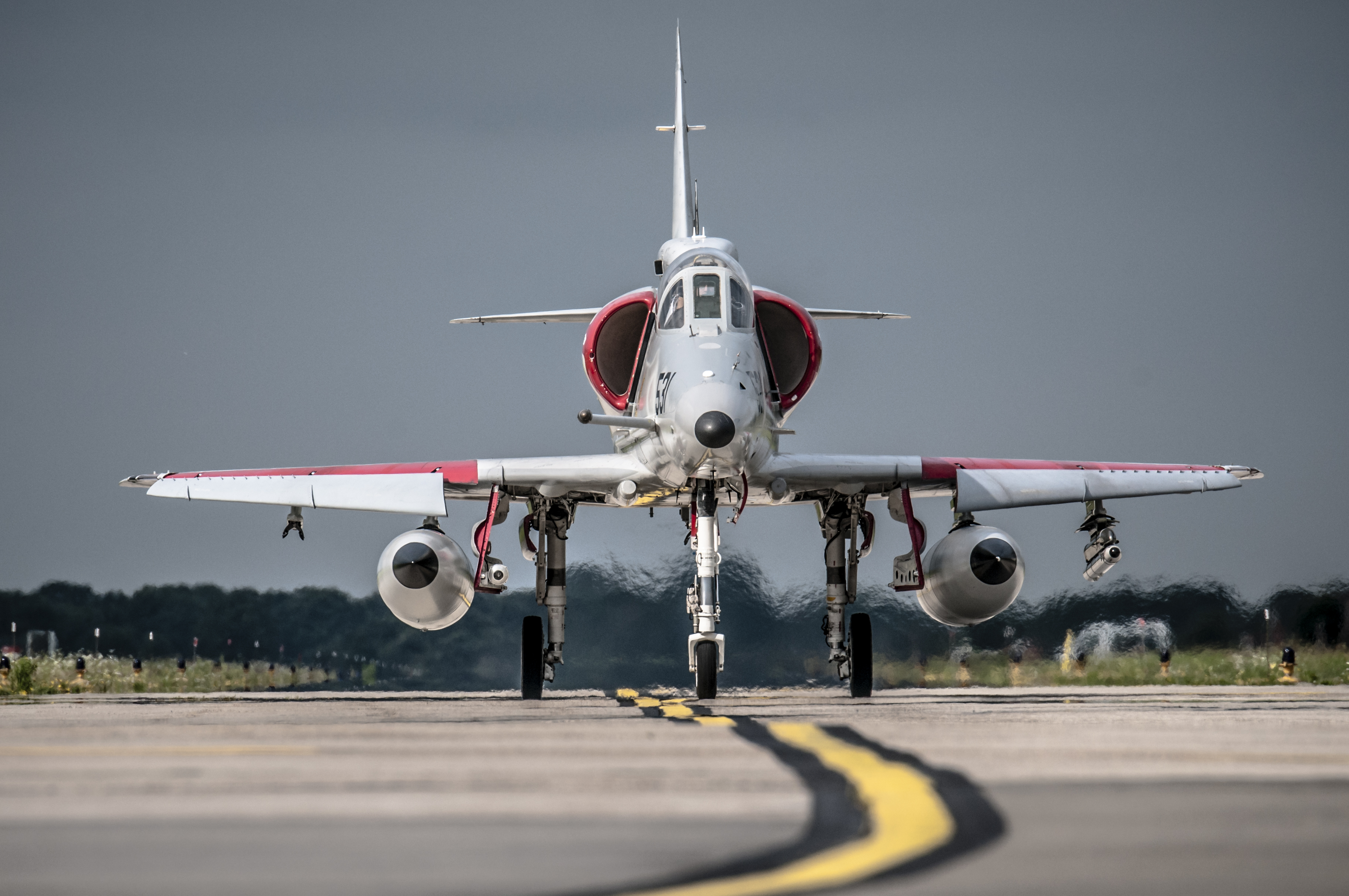
It’s also possible that some of the Top Aces F-16s — 29 of which have been acquired — or some of its 25 subsonic Alpha Jets could end up working in Europe, to support the growing demand for high-end red air assets there. For the German Luftwaffe, which is acquiring more advanced Eurofighters fitted with their own extremely powerful AESA radar, and potentially also F/A-18E/F Super Hornets, EA-18G Growler electronic attack aircraft, and yet more Eurofighters, the requirement for a capable aggressor type to push its frontline pilots is clear.

The company has also said it wants to expand its footprint in the United Kingdom, where an ambitious aggressor and readiness training program, known as Air Support to Defence Operational Training (ASDOT), was shelved in 2019. This would have covered a whole range of U.K. military training requirements, from air-to-air adversary to airspace battle management and live gunnery. All these requirements will now have to be met in different ways.
The Skyhawk is far from new, indeed it first took to the air in 1954, but it has developed a reputation for reliability and efficiency. Furthermore, it is agile and presents a tricky visual target. The fact it can accommodate cutting-edge technologies suggests the Skyhawk still has a long career as an aggressor ahead of it.
Contact the author: thomas@thedrive.com
